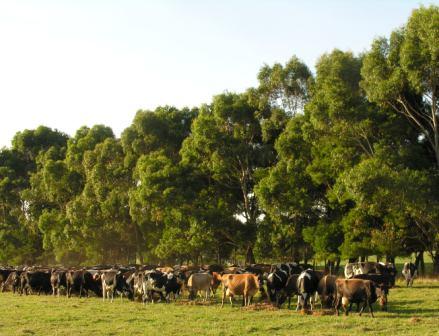Use Edges and Value the Marginal
by Dominique Chanovre
Quite often we come across the Permaculture Principles and view them as singular principles to apply in a given situation. However, as many of us know, they are a process. We start from the beginning in our process and work our way around the spiral of the process to ensure that our work is effectively creating a natural solution, instead of a linear process of input and output.
This ebb and flow of momentum – of spiralling back and forth – moves us forward like the up and down motion of wings on a bird, with the air eddying under our wings lifting us against the force of gravity, and defying the expectations of something heavier than air being able to float. This example may be somewhat creative, however let’s just go with it for now. As they say, use edges and value the marginal, the marginal and edge of the flow of air over a surface, whether it be a wing or a tree.
A wind break on the edge of a farm field, where the wind flows across the neighbour’s pasture and hits your eucalypts in the upper and lower canopy, thus being forced upwards over the emergent layer then spiralling and eddying, slowing down and dropping onto the other side into your zone four grazing animal pasture. However it is a hot day, plus it is an easterly, and your ruminants are being sweltered by the hot surrounding breeze and high temperatures. What can you creatively do? These hot days are not letting up and your trees are starting to lose colour in their leaves and dry out too.
Typically we would put in more wind rows, and allow the ruminants to graze in between the alley cropping in a micro climate, ensuring there is also a large dam nearby to allow them to quench their thirst. Or the problem is the solution and we would find some stock that are bred to be resilient to the sweltering northern WA heat, or both of these solutions would suffice.
But your budget is short and you have no time – it is hot today. Well here is a creative solution that is cheap and may have some use: “Adjust the mineral content of your cows’ ration by increasing sodium, potassium, and magnesium levels.”1. This is similar to taking electrolytes – as a mineral lick or a wholefood form – which can allow them to cope better with heat stress.
There is also the option of fermented foods. Researchers have found that “Supplementing their diet with probiotics is an effective approach to improving livestock welfare.”2 Just like humans, healthy nutrition improves the body’s ability to cope with climatic factors. Whether uptake is in solid or liquid form depends, so do your research as this is only a creative suggestion for the sake of this article.
There is a lot of available information out there and, although a lot comes from industrial farming sites, much is also scientifically researched. We cannot dismiss the emergency aid of such medicinal traditional fundamental organic elements when considering solutions. If anything, consider this context as first aid for your animals – an emergency stop gap solution – until the biological content of your soils and pasture are luscious, and your previous organic feed from last season is abundant.
Finally observe and interact – does this solution create a noticeable difference for your cattle coping with heat stress? Are they sweating more or less? Are they standing or sitting under trees, alone, in groups, for how long? Are they moving, grazing, drinking water? Do they look healthy?
As permaculture solutions in Australia cope with a changing climate, we must begin to use the edges and value the marginal even in our own field at times. Creatively use and respond to change in difficult, disastrous situations and observe and interact to see if we can add them to our toolkit of solutions that work.
References
- https://www.reidstockfeeds.com.au/effective-heat-stress-management-for-cattle/
- Cai L, Hartanto R, Zhang J, Qi D. Clostridium butyricum Improves Rumen Fermentation and Growth Performance of Heat-Stressed Goats In Vitro and In Vivo. Animals (Basel). 2021 Nov 15;11(11):3261. doi: 10.3390/ani11113261. PMID: 34827993; PMCID: PMC8614545.
* Note this reference is for heat stressed goats, however research also supports this for cattle.

